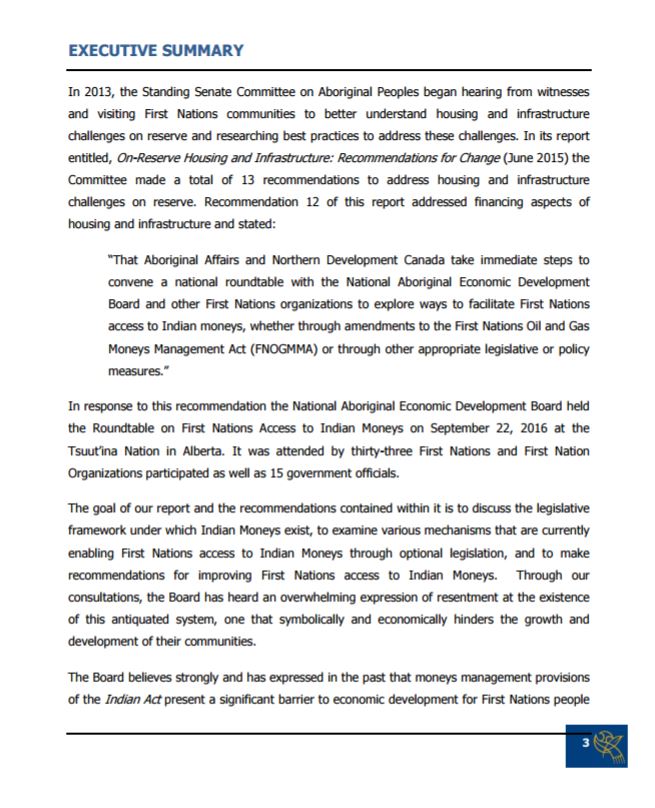Recommendations for improving First Nations access to Indian Moneys
In June 2015, the Standing Senate Committee on Aboriginal Peoples recommended that Indigenous and Northern Affairs Canada convene a national roundtable with the National Indigenous Economic Development Board (NIEDB) and other First Nations organizations to explore ways to facilitate First Nations access to Indian moneys. In response to this recommendation the NIEDB held the Roundtable on First Nations Access to Indian Moneys on September 22, 2016 at the Tsuut’ina Nation in Alberta. It was attended by thirty-three First Nations and First Nation Organizations participated as well as 15 government officials.
Our most recent report, Recommendations on First Nations Access to Indian Moneys, summarizes this roundtable discussion and makes recommendations to the Government of Canada on increasing First Nations access to Indian moneys.
What are Indian Moneys?
Indian Moneys are those moneys belonging to First Nations bands or individuals, including capital and revenue moneys, which are held in trust by Canada. Due to the Government of Canada’s fiduciary duty, Indian Moneys must be placed in the Consolidated Revenue Fund (CRF) for the “benefit” of a First Nation. This means that First Nations face challenges in accessing their revenues which other governments and individuals in Canada do not face, including the following:
- Indian Moneys are kept in the Consolidated Revenue Fund at low rates of interest, resulting in a lower rate of return than could otherwise be obtained.
- First Nations are sometimes forced to wait for long periods of time to access the capital moneys required to purchase the assets necessary for community well-being and economic progress.
- First Nations must request and justify the release of their own moneys from the Consolidated Revenue Fund, which has been described by roundtable participants as an affront to the dignity and rights of First Nations.
First Nations face significant barriers to economic development not faced by other levels of government, including access to Indian moneys. Due to years of economically restrictive policies and controlling legislation, First Nations have limited options to access their revenue streams. In particular, the moneys management provisions of the Indian Act are not conducive to taking advantage of opportunities in a timely fashion, or to building a competitive investment environment.
Our Board recognizes that First Nations must have the ability to exercise control and jurisdiction over a broad range of areas, and that First Nations are most successful when they have the statutory authority to make decisions about their own economic development. It is our hope that these recommendations will support approaches that will provide First Nations with greater access to and collection of Indian Moneys.
Executive Summary (2017)
Full Report (2017)
The NIEDB
Established in 1990, the National Indigenous Economic Development Board is a Governor in Council appointed board mandated to provide strategic policy advice to the federal government on issues related to Indigenous economic development. Comprised of First Nations, Inuit, and Métis business and community leaders from across Canada, the Board helps governments to respond to the unique needs and circumstances of Indigenous peoples in Canada.


